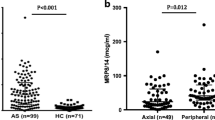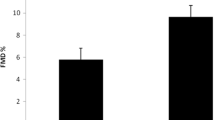Abstract
Recently, it has been reported that ankylosing spondylitis (AS) was characterised by endothelial dysfunction and the development of atherosclerotic complications. In this study, we evaluated platelet and endothelial activation parameters in AS patients. Fiftynine AS patients and 22 healthy controls were included. The clinical features and acute phase parameters were evaluated. In all patients and healthy controls, platelet-monocyte complexes (PMC), platelet-neutrophil complexes, basal and ADP-stimulated P-selectin (CD62P) expression were determined by flow cytometry; soluble E-selectin (sE-selectin) and soluble CD40L (sCD40L) were determined by ELISA. AS patients were divided into two groups as active and inactive by using BASDAI. In 15 AS patients, the evaluated parameters were assessed before and after 12 weeks of anti-TNF therapy. PMC and sCD40L levels in AS patients were significantly higher than in the control group (P values 0.013 and 0.016). The evaluated variables were similar in active and inactive AS groups (P > 0.05). There were no significant changes in platelet and endothelial activation parameters in AS patients after anti-TNF therapy (P > 0.05). Platelet activation which is reflected by high levels of PMC and sCD40L might be responsible for the increased frequency of atherosclerosis in AS. The platelet activation in our AS patients was not associated with disease activity and did not improve after anti-TNF therapy.
Similar content being viewed by others
References
Pasceri V, Yeh ET (1999) A tale of two diseases: atherosclerosis and rheumatoid arthritis. Circulation 100:2124–2126
Manzi S, Meilahn EN, Rairie JE, Conte CG, Medsger TA Jr, Jansen-McWilliams L et al (1997) Age-specific incidence rates of myocardial infarction and angina in women with systemic lupus erythematosus: comparison with the framingham study. Am J Epidemiol 145:408–415
Sari I, Okan T, Akar S, Cece H, Altay C, Secil M et al (2006) Impaired endothelial function in patients with ankylosing spondylitis. Rheumatology 45:283–286
Mathieu S, Joly H, Baron G, Tournadre A, Dubost JJ, Ristori JM et al (2008) Trend towards increased arterial stiffness or intima-media thickness in ankylosing spondylitis patients without clinically evident cardiovascular disease. Rheumatology 47:1203–1207
Agewall S (2003) Is impaired flow-mediated dilatation of the brachial artery a cardiovascular risk factor? Curr Vasc Pharmacol 1:107–109
Sattar N (2004) Inflammation and endothelial dysfunction: intimate companions in the pathogenesis of vascular disease? Clin Sci 106:443–445
Gawaz M, Langer H, May AE (2005) Platelets in inflammation and atherogenesis. J Clin Invest 115:3378–3384
Huo Y, Ley KF (2004) Role of platelets in the development of atherosclerosis. Trends Cardiovasc Med 14:18–22
André P (2004) P-selectin in haemostasis. Br J Haematol 126:298–306
Vandendries ER, Furie BC, Furie B (2004) Role of P-selectin and PSGL-1 in coagulation and thrombosis. Thromb Haemost 92:459–466
Joseph JE, Harrison P, Mackie IJ, Isenberg DA, Machin SJ (2001) Increased circulating platelet-leucocyte complexes and platelet activation in patients with antiphospholipid syndrome, systemic lupus erythematosus and rheumatoid arthritis. Br J Haematol 115:451–459
Sarma J, Laan CA, Alam S, Jha A, Fox KA, Dransfield I (2002) Increased platelet binding to circulating monocytes in acute coronary syndromes. Circulation 105:2166–2171
Furman MI, Barnard MR, Krueger LA, Fox ML, Shilale EA, Lessard DM et al (2001) Circulating monocyte-platelet aggregates are an early marker of acute myocardial infarction. J Am Coll Cardiol 38:1002–1006
Inwald DP, McDowall A, Peters MJ, Callard RE, Klein NJ (2003) CD40 is constitutively expressed on platelets and provides a novel mechanism for platelet activation. Circ Res 92:1041–1048
Wagner AH, Güldenzoph B, Lienenlüke B, Hecker M (2004) CD154/CD40-mediated expression of CD154 in endothelial cells: consequences for endothelial cell-monocyte interaction. Arterioscler Thromb Vasc Biol 24:715–720
Van der Linden S, Valkenburg HA, Cats A (1984) Evaluation of diagnostic criteria for ankylosing spondylitis. A proposal for modification of the New York criteria. Arthritis Rheum 27:361–368
Villmow T, Kemkes-Matthes B, Matzdorff AC (2002) Markers of platelet activation and platelet-leukocyte interaction in patients with myeloproliferative syndromes. Thromb Research 108:139–145
Krueger LA, Barnard MR, Frelinger AL, Furman MI, Michelson AD. (1997) Current protocols in cytometry. In: Robinson JP, Darzynkiewicz Z, Dean PN, Dresiler LG, Rabinovitch PS, Stewart CC, Tanke HJ, Wheeless MC (eds), 1st edn. Wiley, New York Unit 6.10, p. 1–17
Michelson AD, Barnard MR, Krueger LA, Valeri CR, Furman MI (2001) Circulating monocyte-platelet aggregates are a more sensitive marker of in vivo platelet activation than platelet surface P-selectin: studies in baboons, human coronary intervention, and human acute myocardial infarction. Circulation 104:1533–1537
Wang F, Yan CG, Xiang HY, Xing T, Wang NS (2008) The significance of platelet activation in ankylosing spondylitis. Clin Rheumatol 27:767–769
Pamuk GE, Vural O, Turgut B, Demir M, Pamuk ON, Cakir N (2008) Increased platelet activation markers in rheumatoid arthritis: are they related with subclinical atherosclerosis? Platelets 19:146–154
Tamura N, Kobayashi S, Kato K, Bando H, Haruta K, Oyanagi M et al (2001) Soluble CD154 in rheumatoid arthritis: elevated plasma levels in cases with vasculitis. J Rheumatol 28:2583–2590
Toubi E, Shoenfeld Y (2004) The role of CD40-CD154 interactions in autoimmunity and the benefit of disrupting this pathway. Autoimmunity. 37:457–464
Aukrust P, Damas JK, Solum NO (2004) Soluble CD40 ligand and platelets: self-perpetuating pathogenic loop in thrombosis and inflammation? J Am Coll Cardiol 43:2326–2328
Wimalasundera R, Fexby S, Regan L, Thom SA, Hughes AD (2003) Effect of tumour necrosis factor-alpha and interleukin 1beta on endothelium-dependent relaxation in rat mesenteric resistance arteries in vitro. Br J Pharmacol 138:1285–1294
Hürlimann D, Forster A, Noll G, Enseleit F, Chenevard R, Distler O et al (2002) Anti-tumor necrosis factor-alpha treatment improves endothelial function in patients with rheumatoid arthritis. Circulation 106:2184–2187
Gonzalez-Juanatey C, Testa A, Garcia-Castelo A (2004) Transient improvement of endothelial function in rheumatoid arthritis patients undergoing long-term treatment with anti-tumor necrosis factor-α antibody. Arthritis Rheum 51:447–450
Baeten D, Kruithof E, Van den Bosch F, Demetter P, Van Damme N, Cuvelier C et al (2001) Immunomodulatory effects of anti-tumor necrosis factor alpha therapy on synovium in spondylarthropathy: histologic findings in eight patients from an open-label pilot study. Arthritis Rheum 44:186–195
Choe JY, Lee MY, Rheem I, Rhee MY, Park SH, Kim SK (2008) No differences of carotid intima-media thickness between young patients with ankylosing spondylitis and healthy controls. Joint Bone Spine 75:548–553
Acknowledgment
This study was supported by the Scientific research projects’ fund of Trakya University (Project Number: TÜBAP-870).
Author information
Authors and Affiliations
Corresponding author
Rights and permissions
About this article
Cite this article
Örüm, H., Pamuk, G.E., Pamuk, Ö.N. et al. Does anti-tnf therapy cause any change in platelet activation in ankylosing spondylitis patients?. J Thromb Thrombolysis 33, 154–159 (2012). https://doi.org/10.1007/s11239-011-0663-9
Published:
Issue Date:
DOI: https://doi.org/10.1007/s11239-011-0663-9




